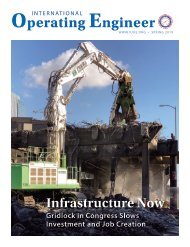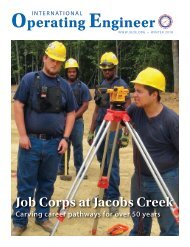125 Years Strong – An IUOE History
Celebrating the 125th Anniversary of the founding of the International Union of Operating Engineers
Celebrating the 125th Anniversary of the founding of the International Union of Operating Engineers
Create successful ePaper yourself
Turn your PDF publications into a flip-book with our unique Google optimized e-Paper software.
INTERNATIONAL UNION OF OPERATING ENGINEERS<br />
UNION ADVANCED CIVIL RIGHTS<br />
During the surge of the civil-rights movement in the 1960s, Manpower Development and Training Act of 1962, the Vocational<br />
the I.U.O.E. and most of the construction trades were targeted Education Act of 1963 and the Economic Opportunity Act of<br />
by civil-rights advocates because of the low number of minorities 1964. Regardless, the I.U.O.E., as did other construction-trades<br />
in building-trades unions and their apprenticeship programs <strong>–</strong> unions, still faced charges of discrimination, and in 1968, the<br />
although, as Professor Garth L. Mangum notes in Union Resilience Department of Labor’s Office of Federal Contract Compliance<br />
in Troubled Times from 1993, racism was not the sole cause began withholding funds from federally financed projects in several<br />
of the disparity. While discrimination did exist within unions, he locations until minority quotas were met and its “Philadelphia<br />
explains that because building trades unions were “organized by Plan,” a quota system for hiring minority workers in the trades,<br />
men of the white working class … entrance into the unions often was imposed.<br />
was determined by family ties and/or personal connections” …<br />
and, therefore, “few minorities (as well as white males without<br />
‘connections’) entered the union because they were outside the<br />
traditional entry route.”<br />
For the most part, into the culturally charged Sixties, the I.U.O.E.<br />
left its locals to address issues of racism and racial disparity among<br />
their own respective ranks; but with the growth of its hoisting<br />
and portable branch (which primarily required entry through the<br />
union’s selective training programs), overall minority membership<br />
in the union declined. Subsequently, even before the civil-rights<br />
movement gained momentum in the mid-1960s, in May 1961<br />
the I.U.O.E. issued a Statement on Civil Rights:<br />
Since it was chartered in 1896, the International<br />
Union of Operating Engineers has been dedicated<br />
to the proposition that all men are created equal.<br />
Our history clearly demonstrates that color, religion<br />
or national origin has never been a bar to the full<br />
enjoyment of membership. At the present time we<br />
number among our ranks many representatives<br />
of minority racial and religious groups.<br />
While we take justifiable pride in the advances<br />
made to improve the wages, hours and working<br />
conditions of our membership, we have never lost<br />
sight of our consistent policy to aid and encourage<br />
all workers within our craft, without regard to race,<br />
creed, color, national origin, or ancestry, to share<br />
equally, in the full benefits of membership in this<br />
International Union. Deviation from this policy, no<br />
matter how slight, has always been opposed by<br />
this International Union.<br />
The International Union of Operating Engineers<br />
will affirmatively cooperate, within the limits<br />
of its local and contractual authority, in the<br />
implementation of the policy and provisions of<br />
the Executive Order establishing the President's<br />
Committee on Equal Employment Opportunity,<br />
issued by the President of the United States on<br />
March 6, 1961.<br />
The I.U.O.E. also supported campaigns that helped pass the<br />
Civil Rights Act of 1964, the Voting Rights Act of 1966, the<br />
Conversely, the I.U.O.E. considered its training programs to be<br />
the solution for increasing minority representation, and in August<br />
1968, General President Hunter P. Wharton appointed Brother<br />
James H. Gary to the International staff with the task of assisting<br />
the international union and its locals in resolving internal civil-rights<br />
issues. Soon after, the union initiated an Affirmative Action Plan for<br />
locals first in Pennsylvania and Ohio and then in Los <strong>An</strong>geles; New<br />
York City; Indianapolis; Atlanta; the state of Michigan; Chicago;<br />
Birmingham; and Hamden, Connecticut.<br />
While efforts to make the union more inclusive continued, on<br />
July 1, 1977, General President J. C. Turner created a Department<br />
of Civil Rights and appointed Brother Louis J. Brady of Local No. 3<br />
in San Francisco as its director. General President Frank Hanley’s<br />
administration later combined the Department of Civil Rights with<br />
LOCALS AT FOREFRONT<br />
OF FOSTERING EQUALITY<br />
With a creative organizing initiative executed in late<br />
1973, the I.U.O.E. was able to use the civil-rights issue<br />
as an organizing tool against open-shop contractors in a<br />
predominantly non-union area. As part of the program,<br />
Local No. 312 of Alabama and Local No. 624 of Mississippi<br />
sponsored training programs to prepare minority residents<br />
in their historically non-union states with entry-level skills as<br />
heavy-equipment operators and mechanics for the $1-billion<br />
Tennessee-Tombigbee (Tenn-Tom) Waterway Project, a<br />
series of projects connecting the Tennessee River with the<br />
Gulf of Mexico through parts of the two states.<br />
The locals also formed a coalition with communityaction<br />
groups to protest the low, pre-determined wages for<br />
construction of the Tenn-Tom, after which the wage rates<br />
were dramatically increased. Because of the efforts of the<br />
I.U.O.E. locals, union contractors also were the successful<br />
bidders on three of the four major contracts awarded through<br />
1975 after a non-union contractor was awarded the first<br />
contract on the project.<br />
IN ITS INDUSTRY<br />
the union’s Office of Organization, thereby making the recruitment of<br />
minorities one of the priorities of its organizing endeavors.<br />
By the early 1990s, the I.U.O.E. had “minimized” its civil-rights<br />
discrepancies, as Union Resilience in Troubled Times points out. In<br />
doing so, the union opened entry into its membership by actively<br />
recruiting minority and women apprentices, while an increase in<br />
I.U.O.E. workers in the public sector resulted in an increase in new<br />
minority and female members. “In other words,” Professor Mangum<br />
declares, “the ‘loop’ that was previously closed to minorities and<br />
women has been substantially widened.”<br />
MEMBER BROKE RACIAL BARRIERS<br />
I.U.O.E. Brother James E. Keyes Sr. was the first black business<br />
representative for any construction union in the United States when<br />
he assumed that position for I.U.O.E. Local No. 478 of Connecticut<br />
in the early 1970s. During<br />
his time with the union,<br />
Brother Keyes helped<br />
establish the international’s<br />
Apprenticeship and Training<br />
Programs for minorities<br />
and women in every state<br />
in the country, and among<br />
many other activities he also<br />
worked closely with national<br />
civil rights groups, outreach<br />
agencies and the Job Corps<br />
I.U.O.E. Local No. 478 Brother<br />
James E. Keyes Sr.<br />
to promote and assist with<br />
the referral and placement<br />
of minorities and women into<br />
construction unions.<br />
For all of his efforts, the New Haven, Connecticut, Branch of the<br />
N.A.A.C.P. presented its 1983 Freedom Award to Brother Keyes. After<br />
11 more years of service to the union and community, he passed away<br />
on September 25, 1994.<br />
Fittingly, as a delegate to the I.U.O.E. 33 rd Convention in 1988,<br />
Brother Keyes seconded the re-nomination of international trustee and<br />
close friend Brother Peter Babin of Local No. 406 in New Orleans with<br />
this tribute:<br />
“It’s kind of strange for me and for maybe<br />
some of you people here assembled for a<br />
Yankee who is black from the North to stand<br />
at this microphone to second the nomination<br />
for a rebel who is white from the South. This<br />
could only happen in real, true spirit in the<br />
labor movement.”<br />
to-work law.” (While throughout the<br />
coming decades through to its <strong>125</strong> th<br />
anniversary in 2021, the union<br />
would spend an untold amount of its<br />
political resources fending off “rightto-work”<br />
attacks at state and national<br />
levels.)<br />
The 1960s were years of more<br />
growth for the I.U.O.E., and<br />
already in 1960, the operating<br />
engineers reaped the benefits of<br />
their union’s ambitious organizing<br />
drive as the membership climbed to<br />
more than 302,000 that year. (2) The<br />
work situation in the construction<br />
industry was also favorable,<br />
highlighted by numerous pipeline<br />
fabrication jobs, and a substantial<br />
majority of it was being done with<br />
union labor.<br />
But during the union’s 26 th<br />
General Convention, held in Florida<br />
in April 1960, delegates conceded<br />
constitutional amendments made<br />
necessary by harsh mandates of the<br />
recently passed, anti-union federal<br />
Landrum-Griffin Act (officially the<br />
Labor-Management Reporting and<br />
Disclosure Act) that put in place<br />
measures to regulate labor unions’<br />
internal affairs such as voting and<br />
reporting of certain activities.<br />
Regardless, after the conference<br />
was completed, President Delaney<br />
declared, “Our union has emerged<br />
from this convention strengthened,<br />
invigorated and unified in spirit<br />
and purpose.”<br />
One reason for that encouraging<br />
outlook was the convention’s<br />
approval of a plan for developing a<br />
union-wide Central Pension Fund.<br />
While larger and stronger locals<br />
had begun in the 1950s to negotiate<br />
LABOR OMNIA VINCIT<br />
WORK CONQUERS ALL
















